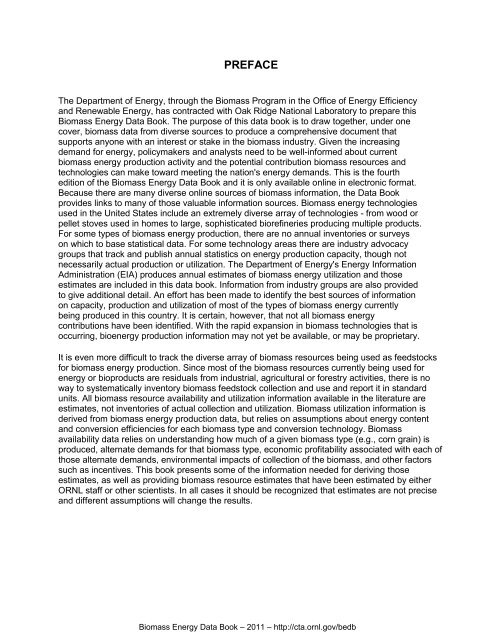Biomass Energy Data Book: Edition 4 - Full Document - Center for ...
Biomass Energy Data Book: Edition 4 - Full Document - Center for ...
Biomass Energy Data Book: Edition 4 - Full Document - Center for ...
You also want an ePaper? Increase the reach of your titles
YUMPU automatically turns print PDFs into web optimized ePapers that Google loves.
PREFACE<br />
The Department of <strong>Energy</strong>, through the <strong>Biomass</strong> Program in the Office of <strong>Energy</strong> Efficiency<br />
and Renewable <strong>Energy</strong>, has contracted with Oak Ridge National Laboratory to prepare this<br />
<strong>Biomass</strong> <strong>Energy</strong> <strong>Data</strong> <strong>Book</strong>. The purpose of this data book is to draw together, under one<br />
cover, biomass data from diverse sources to produce a comprehensive document that<br />
supports anyone with an interest or stake in the biomass industry. Given the increasing<br />
demand <strong>for</strong> energy, policymakers and analysts need to be well-in<strong>for</strong>med about current<br />
biomass energy production activity and the potential contribution biomass resources and<br />
technologies can make toward meeting the nation's energy demands. This is the fourth<br />
edition of the <strong>Biomass</strong> <strong>Energy</strong> <strong>Data</strong> <strong>Book</strong> and it is only available online in electronic <strong>for</strong>mat.<br />
Because there are many diverse online sources of biomass in<strong>for</strong>mation, the <strong>Data</strong> <strong>Book</strong><br />
provides links to many of those valuable in<strong>for</strong>mation sources. <strong>Biomass</strong> energy technologies<br />
used in the United States include an extremely diverse array of technologies - from wood or<br />
pellet stoves used in homes to large, sophisticated biorefineries producing multiple products.<br />
For some types of biomass energy production, there are no annual inventories or surveys<br />
on which to base statistical data. For some technology areas there are industry advocacy<br />
groups that track and publish annual statistics on energy production capacity, though not<br />
necessarily actual production or utilization. The Department of <strong>Energy</strong>'s <strong>Energy</strong> In<strong>for</strong>mation<br />
Administration (EIA) produces annual estimates of biomass energy utilization and those<br />
estimates are included in this data book. In<strong>for</strong>mation from industry groups are also provided<br />
to give additional detail. An ef<strong>for</strong>t has been made to identify the best sources of in<strong>for</strong>mation<br />
on capacity, production and utilization of most of the types of biomass energy currently<br />
being produced in this country. It is certain, however, that not all biomass energy<br />
contributions have been identified. With the rapid expansion in biomass technologies that is<br />
occurring, bioenergy production in<strong>for</strong>mation may not yet be available, or may be proprietary.<br />
It is even more difficult to track the diverse array of biomass resources being used as feedstocks<br />
<strong>for</strong> biomass energy production. Since most of the biomass resources currently being used <strong>for</strong><br />
energy or bioproducts are residuals from industrial, agricultural or <strong>for</strong>estry activities, there is no<br />
way to systematically inventory biomass feedstock collection and use and report it in standard<br />
units. All biomass resource availability and utilization in<strong>for</strong>mation available in the literature are<br />
estimates, not inventories of actual collection and utilization. <strong>Biomass</strong> utilization in<strong>for</strong>mation is<br />
derived from biomass energy production data, but relies on assumptions about energy content<br />
and conversion efficiencies <strong>for</strong> each biomass type and conversion technology. <strong>Biomass</strong><br />
availability data relies on understanding how much of a given biomass type (e.g., corn grain) is<br />
produced, alternate demands <strong>for</strong> that biomass type, economic profitability associated with each of<br />
those alternate demands, environmental impacts of collection of the biomass, and other factors<br />
such as incentives. This book presents some of the in<strong>for</strong>mation needed <strong>for</strong> deriving those<br />
estimates, as well as providing biomass resource estimates that have been estimated by either<br />
ORNL staff or other scientists. In all cases it should be recognized that estimates are not precise<br />
and different assumptions will change the results.<br />
<strong>Biomass</strong> <strong>Energy</strong> <strong>Data</strong> <strong>Book</strong> – 2011 – http://cta.ornl.gov/bedb
















